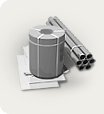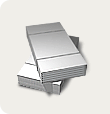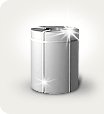3-D printing takes its first steps in the construction sector. At the Grote Marktstraat in The Hague, the Netherlands, the international design consultancy Arup has 3-D printed a steel structure to create a "Cloud of Lights" lighting system.
The project began with the idea that 3-D printing could save time and solve the problem of multiple connections. The existing project required 1,600 steel assemblies for connecting posts and pull wires with some design variations of 1,200 in each component. The structures formed three giant chandeliers floating in the air in The Hague at the Grote Marktstraat. The lighting built into the structure only enhanced the spatial perception. The impression was complemented by the fact that outdoor lighting poles standing just a few meters from the lamps floating in the air, reminded of the need to support the light source.
At the first stage, the creation of nodes with a traditional method of manufacturing from steel sheets and welded seams was considered. The team felt that a better option could be found, as each element had to be tuned with greater precision. This can only be achieved with 3-D metal printing, which involves a sintering process in which metal powder is melted and formed using a computer-controlled laser. The team proceeded to prototype with the knowledge that the nodes needed to have structural integrity, holes for cables and threaded rods.
The team explained, “We turned our attention to the aviation and automotive industries, which already use 3-D printing for rapid prototyping, but they weren't willing to share their secrets with us. Then we started to think about what is needed for this. " As a result, we have achieved a more aesthetically pleasing and organic design than what is usually produced in the steel workshop.
Interestingly, thanks to 3-D printing, some assemblies are 30 percent lighter and some are 75 percent lighter. Reducing the weight of the nodes led to the recalculation of the loads of the entire structure. It was found that the amount of material was reduced overall by 40 percent. The end product has also changed slightly and the attachment points have been better integrated. The team is confident that they have proven the feasibility of using 3-D printing in complex designs.
In the Netherlands, 3-D printing was used to create structural steel components

|
|
Azovpromstal® 8 August 2015 г. 14:30 |





